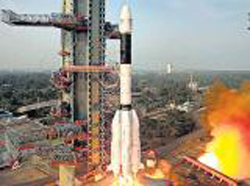India successfully test fires GSLV Mark-III; PM Narendra Modi congratulates ISRO scientists
Mangalore Today News Network
Sriharikota, Dec 18, 2014: India’s space agency today successfully launched its heaviest rocket ever - the 630-tonne, three-stage Geo-Synchronous Satellite Launch Vehicle Mark III - with an experimental crew module. The mission will take the Indian Space Research Organisation or ISRO a step closer to sending astronauts to space.  Prime Minister Narendra Modi tweeted, "Successful launch of GSLV Mk-III is yet another triumph of brilliance & hard work of our scientists. Congrats to them for the efforts.
Prime Minister Narendra Modi tweeted, "Successful launch of GSLV Mk-III is yet another triumph of brilliance & hard work of our scientists. Congrats to them for the efforts.
"
After its blast-off from Sriharikota in Andhra Pradesh, the 42.4 m expendable rocket ascended to the sky with a one-way ticket as its design life span is just around five minutes. (See Pictures)
The Rs. 160 crore mission tests the rocket’s atmospheric flight stability powered by two engines with around four-tonne luggage.
The GSLV Mk III is a new rocket design and also marks the beginning of what could be India’s initiation into the ambitious human space flight programme. Its main passenger is an Indian-made 3.7 tonne crew module capable of taking two or three astronauts to space.
Just over five minutes into the flight, the rocket ejected the giant cupcake shaped crew module at an altitude of 126 km.
The unmanned crew module was navigated by remote-control and made to re-enter the atmosphere at a massive velocity. It was slowed down with massive parachutes, the largest ever to be used by India, before it splashed down in the Bay of Bengal.
For the country, ISRO perfecting the cryogenic engine technology is crucial as India can save precious foreign exchange by launching heavy duty communication satellites by itself.
On this flight, the rocket is being tested on how it performs while traveling in the atmosphere. Its first two stages are active rocket engines and the third stage, which consists of the cryogenic engine, is passive.
ISRO has said it can fly astronauts to space using a made-in-India rocket within seven to eight years of getting the government’s clearance for its astronaut programme.
The space agency has sought around Rs. 12,500 cr for its human space flight mission. When it happens, India will become the fourth country in the world to have the technology of sending humans into space, after the US, Russia and China.
Courtesy: Deccan Herald
- Mangaluru: Commissioner denies misuse of police vehicle during Waqf protest, cites medical emergency
- Belthangady: Autorickshaw overturns near Ujire; driver seriously injured
- Chikkamagaluru: KSRTC driver attempts suicide over alleged harassment by senior officer
- Former don Muthappa Rai’s son injured after being shot at in moving car near Bidadi house
- Mulki: Top portion of Bappanadu temple chariot collapses during Rathotsava; none hurt
- Belthangady youth slips to death in Cauvery river
- Kundapur: Speeding Omni fatally knocks down pedestrian
- Snehalaya and Janamaithri Police launch anti-Drug awareness drive at Uppal and Hosangadi
- Mangaluru: Fight will continue till amendments to Waqf Act are withdrawn, say Muslim leaders
- Direction to remove Janivara would have come with the knowledge of the govt., says Poojary
- JEE (Main) second edition results to be announced by April 19: NTA
- Three arrested for raping woman in Mangaluru, say police
- Summer rush: Special trains, Vande Bharat sleeper announced for Mangaluru
- Honour to speak with PM Modi, will visit India later this year: Elon Musk
- India tears into Yunus regime over Hindu leader’s killing in Bangladesh
- Two homeguards suspended for asking students to remove sacred thread at Shivamogga college
- Caste census report politically motivated, says R Ashoka
- PM Modi to visit Saudi Arabia from April 22-23
- 4 dead, many feared trapped as building collapses in Delhi’s Mustafabad
- Kerala teacher acquitted as student confesses fake rape allegation
- CET officials booked for asking students to remove sacred thread at exam centre in Shivamogga
- BJP worker found hanging in Bengaluru outskirts, video message names ‘local leader’
- CET row: Karnataka govt orders probe after students asked to remove sacred thread
- Man who flashed woman, assaulted 7 people arrested in Bengaluru
- FIR against Sunny Deol, Randeep Hooda for offending Christian religious sentiments in Jaat
- Skills and Competencies Take Center Stage at MSN Dialogue Series
- Court remands Maoist Lakshmi to six-day police custody
- Sandhya Shenoy honored with Society for Materials Chemistry Medal-2024
- White Cornus Apartment in Mangaluru
- City girl wins first place in state-level spell bee competition
- Alleged ‘Love Jihad’ Case in Mangaluru: Woman left home voluntarily, says police
- Girl fatally struck by reckless two-wheeler near Belman
- New residential complex for the judges inaugurated in Mangaluru
- Absconding accused nabbed after 8 years
- Truck with cylinders turns turtle in Beltangady
- Bhoota Kola artist dies of cardiac arrest
- Development of the country should be our goal: Ganesh Karnik
- Container truck gets stuck under Modankap railway bridge
- Truck crushes bike’s pillion rider near BC Road
- Head constable dies of heart attack
- CITY INFORMATION
- TRAVEL
- TOURIST INFORMATION
- HEALTH CARE
- MISCELLANEOUS




 Write Comment
Write Comment E-Mail To a Friend
E-Mail To a Friend Facebook
Facebook Twitter
Twitter  Print
Print 


